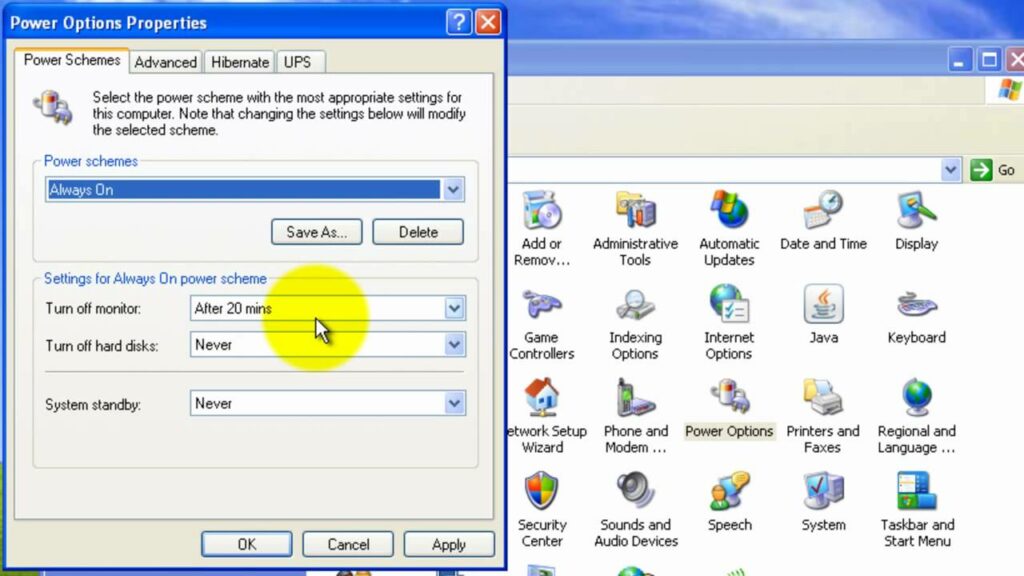Mastering Power Management: A Comprehensive Guide to Configuring Power Options in Windows XP

In the realm of computer usage, optimizing power settings is essential for maximizing performance, extending battery life on laptops, and reducing energy consumption on desktops. Windows XP provides users with a range of power options to customize system behavior according to their preferences and needs. Whether you’re a mobile user looking to conserve battery power or a desktop user aiming to reduce energy consumption, knowing how to configure power options in Windows XP is crucial. In this exhaustive guide, we’ll delve deep into the intricacies of power management, empowering users to harness the full potential of their Windows XP systems with confidence and precision.
Understanding Power Options in Windows XP:
Before we explore the methods for configuring power options, let’s understand the significance of power management within the Windows XP operating system. Power options control the behavior of your computer’s hardware components, including the display, hard drive, and system standby, to optimize power consumption and performance. Windows XP offers several power schemes, such as “Portable/Laptop,” “Desktop,” and “Always On,” each with customizable settings to suit different usage scenarios.
Step-by-Step Guide to Configuring Power Options:
Now, let’s explore a systematic approach to configuring power options in Windows XP:
Step 1: Accessing Power Options:
- Click on the “Start” button located at the bottom-left corner of the screen.
- Navigate to “Control Panel” and double-click to open it.
- In the Control Panel window, locate and open the “Power Options” icon.
Step 2: Choosing a Power Scheme:
- In the Power Options window, navigate to the “Power Schemes” tab.
- Select a predefined power scheme from the drop-down menu, such as “Portable/Laptop,” “Desktop,” or “Always On,” based on your usage scenario.
Step 3: Customizing Power Settings:
- To customize power settings, click on the “Power Options” tab.
- Here, you can adjust settings such as system standby, hard disk power management, and display brightness according to your preferences.
- Click “Apply” and then “OK” to save the changes.
Step 4: Advanced Power Options:
- For more advanced power management settings, click on the “Advanced” tab in the Power Options window.
- Here, you can configure additional options such as processor power management, system cooling policy, and USB selective suspend.
- Make the desired adjustments and click “Apply” and then “OK” to save the changes.
Step 5: Configuring Hibernate and Standby Options:
- To configure hibernate and standby options, navigate to the “Hibernate” and “Standby” tabs in the Power Options window.
- Here, you can specify when the computer should enter standby or hibernate mode and choose whether to prompt for a password upon resuming from standby or hibernate.
- Adjust the settings to meet your requirements and click “Apply” and then “OK” to save the changes.
Using Powercfg Command-Line Tool (Optional):
Advanced users can also configure power options using the powercfg command-line tool in Windows XP. To view available power schemes, open a Command Prompt window and type:
powercfg /list
To set a specific power scheme as the active scheme, type:
powercfg /setactive <scheme GUID>
Conclusion:
In conclusion, configuring power options in Windows XP offers users the flexibility to optimize system performance, extend battery life, and reduce energy consumption according to their preferences and needs. By following the step-by-step guide outlined in this article and exploring advanced configuration options, users can customize their power management experience to suit their usage scenarios effectively. Whether maximizing battery life on laptops or minimizing energy consumption on desktops, mastering the configuration of power options empowers users to harness the full potential of their Windows XP systems with confidence and precision. So take control of power management today and optimize your computing experience for efficiency and performance!




